TAIRYU FURUKAWA'S LIFE STORY
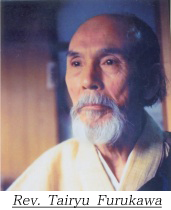
Rev. Tairyu Furukawa was born into a religious family in Saga prefecture, as the oldest of eight children in 1920. He spent his childhood in difficult and poor circumstances. He was sent to China as a soldier in 1940, where he was wounded and hospitalized for a year and then he was returned to Japan. He went to the Koyasan Senshu Institute in Wakayama prefecture to study Buddhism and became the head priest of a temple in his hometown in 1945. After the War, he devoted himself to helping the poor, the sick and the war bereaved, including people suffering from Hansen's disease.
In fact, in 1952, he took *his wife, on their honeymoon, to an isolation ward in Kagoshima for these patients. He used to give his lectures there at that time. She was very surprised to see them enthusiastically waiting for his talk and was greatly touched by the way they welcomed her. After staying one night with them, she firmly decided to support Rev. Furukawa’s work and since then she has continued to devote her whole life to helping his work behind the scenes.
In the same year, he became the editor of the religious review called "Cosmos". Due to the financial problems he faced, a friend asked a prison in Fukuoka to print the copies for him. Some prisoners working in the printing office took copies of the magazines to their cells to read his articles in secret and they were greatly moved and touched by his words. Although taking any papers into one's cell was not permitted, the head of the prison understood their wishes and invited Rev. Furukawa to give his lectures directly to the prisoners. In this exceptional way, he was appointed to be the prison chaplain, especially to care for those who had been condemned to death. Then he encountered two prisoners on death row who had been imprisoned under false charges ; Mr. Nishi and Mr. Ishii. It had taken nine years for the Supreme Court to finalize their sentences and in 1956 both prisoners were given the death penalty.
During this time, Rev. Furukawa had been considering the possibility that the two prisoners could actually be innocent. When the sentences were finalized and he saw the reaction of both men, he became utterly convinced of their innocence. At that time he was, on the one hand, a responsible head of a family of eight struggling with the problems of poverty and, on the other hand, entirely taken up by his personal quest for religious truth. Yet he decided to launch a campaign to obtain a retrial and the reversal of the death sentence for the two prisoners. (Please see Our Work - The Fukuoka Incident.) He had no knowledge of judicial matters and no funds for the campaign. In the face of these difficulties, he set out on a stormy sea with his family in 1961.
Two years later, by the order of the Ministry of Justice, he was barred from working any more as a prison chaplain, because he had started his campaign to free the two prisoners which he was told a chaplain should not do. Yet he did not stop the campaign! In order to raise funds for the campaign, he sold all his property including his wife's and begged for alms throughout the country. Only his family and several friends joined him and went out on the street to collect signatures and funds from passers-by. Whenever the Minister of Justice changed, he went to lodge an appeal against the pending executions, carrying his "Factual Investigation Report", containing more than 2000 Japanese manuscript pages. He worked 12 hours a day, every day, for about 5 months in order to complete this book.
During 40 years of the campaign, there were several unique episodes that happened to him.
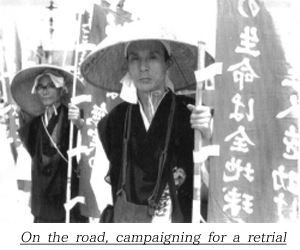
On New Year's day in 1964, a wanted criminal called Mr. Nishiguchi, who had committed five murders and had been fleeing across the country, came to visit Rev. Furukawa's home. Mr. Nishiguchi introduced himself as a lawyer who supported his campaign. However, one of Rev. Furukawa's family noticed Mr. Nishiguchi's resemblance on a wanted person's poster and the actual identity of the criminal was realized by Rev. Furukawa and Mr. Nishiguchi's arrest was made possible. The arrest after a 79 day nationwide search by police drew the attention of the whole country. This publicity helped Rev. Furukawa's campaign to free the two prisoners to gather momentum, attracting many supporters from all over Japan.
One day in 1969 while begging for alms on the street in Kobe, he met by chance the late Mr.Tadashi Mukai, the head of the Dr. Albert Schweitzer Association of Kobe. Mr. Mukai was deeply moved by his selfless actions to save men's lives, and highly esteemed him as a man who put "reverence for life" into practice. A precious relic of Dr. Schweitzer, a lock of hair, was given to him symbolizing a crossing of sectarian boundaries. This gave him great inspiration and to honor the relic he established a new religious institution called The Seimeizan (i.e. Mountain of Life) Schweitzer Temple in 1973. The birth of the temple can be seen as a testament of his campaign to obtain a retrial for the unjustly condemned.
The movement had some surprising developments, but the door to a retrial was not opened. In 1975 at the peak of the campaign, he was in Tokyo trying to obtain amnesty for the two prisoners. At this time, on June 17th , while Mr. Ishii was being granted an amnesty, getting an indefinite commutation of his sentence, Mr. Nishi was suddenly executed. Even though the death sentence had already been finalized by the Supreme Court, Rev. Furukawa succeeded in obtaining the reversal of the death sentence for Mr. Ishii. It was the first such instance in the history of Japanese law. Mr. Nishi, however, who was not even at the scene of the killing, was executed on the same day. The reason why the Ministry of Justice had Mr. Nishi executed and had Mr. Ishii' sentence reduced still remains a mystery to this day.
In accordance with Mr. Nishi's last wish, all his belongings and remains were given to Rev. Furukawa and were enshrined in the temple. This sudden execution, after the desperate efforts of 15 years to save his life, came as an enormous shock to Rev. Furukawa and it took him a long time to get over it.
The campaign, however, did not come to an end.
Every year, in June, on the anniversary of the execution, a memorial service was held, remembering Mr. Nishi' wish; " I do not want anybody to lead such a hard life as I did. I should be the last one." While thinking of the deceased, preparations were still being made for a posthumous retrial. Rev. Furukawa wanted to work as a prison chaplain again, but the wall of the Ministry of Justice was too thick to penetrate and his wish did not come true. Yet he started to practice the" reverence for life " in different ways.
In 1981 he was invited to give his lectures on Thanatology (i.e. the study of death ) at the University of Industrial Medicine. Since then his lectures on the deep meaning of life and death were regularly given to medical students, nurses and doctors across the nation in order to convey the reverence for life.
Furthermore, he shed tears for the people who died brutal deaths during the Second World War, especially for the Chinese people. In 1984 he built a monument in Kumamoto to remember hundreds of Chinese forced laborers who died in the coal mines of Arao during the War, inscribing his words, "Grief transcending national boundaries". In 1985 he took people to China for the first pilgrimage of reconciliation and peace, commemorating the victims of the Nanjing massacre perpetrated by the Japanese army in 1937. In order to make people aware of what had been done in the past and to help establish peace, yearly pilgrimages have been conducted since then.
In the same year, he had a fortunate encounter with Fr. Franco Sottocornola, a Xaverian Missionary Father in Japan, who had the same dream as Rev. Furukawa to create a center for interreligious dialogue. After first meeting him, Fr. Sottocornola immediately decided to come down to Kumamoto to work with him. In 1986 they established "the Center for Interreligious Dialogue", the first instance in Japan of a Buddhist and Christian activity united in one single religious institution.
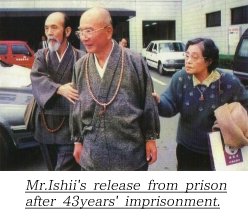
After Rev. Furukawa began working with the Catholic priests and nuns, his working place was not only in Asia, but also extended into Europe. In 1989 he was invited to Europe to give lectures on Interreligious Dialogue during a 40 day stay in Italy and England. He was very honored to have the first encounter with Pope John Paul II in the Vatican and there Rev. Furukawa appealed for World Peace. Later on that year, he was also invited for the first time to the International Conference of Religious Leaders, held by the Community of St.Egidio, in Warsaw, Poland. Since then, he continued to attend these Conferences, giving his talks.
At the end of 1989, after he returned to Japan, there was another important and surprising piece of news awaiting him. Mr. Ishii, one of the innocent prisoners, was released on parole after 42 years and 7 months' imprisonment. He came back to society as an old man already beyond 70 years of age and lived with the Furukawa family at the temple.( He had desires to clear the name of Mr.Nishi, but he passed away at the age of 91 in 2009.)
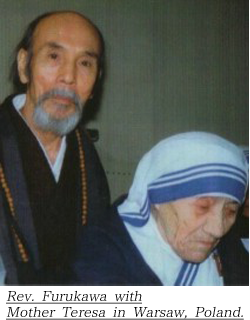
Rev. Furukawa's childhood dream to be an artist was not realized because of the poverty he had to endure, but his artistic talent still vividly remained and was acknowledged not only in Japan but also in Italy. With support of the Xaverian Missionaries, an exhibition of the works of his calligraphy was held in five different cities in Italy in 1994.
At the end of his long stay in Europe, by chance, thanks to divine providence, he had a wonderful opportunity to encounter Mother Teresa in Warsaw, Poland. Since for a long time he had a great respect for her, deep spiritual joy and appreciation filled his heart and encouraged his activities.
In 1998, another great chance arose. This was the encounter with Sr. Helen Prejean in Bucharest, Romania. Together with her he made an appeal to everybody that there should be no more death penalty in the 21st century. His thoughts about the matriarchal principle called, "coexistence and coprosperity", were all the more confirmed by these encounters. After Rev. Furukawa first met Mr. Nishi's bereaved family in 1995, he decided to try to obtain a posthumous retrial and made this a formal announcement.
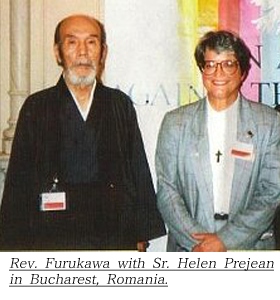
His New Year's message of 1999 showed us his strong will as follows,
"......The truth about the unjust condemnation of Takeo Nishi has not yet been brought to light. Grinding my teeth in chagrin, I have been trying to win him a posthumous retrial and just last year, I was approached by some professional people who will try to make the retrial a reality. As a culmination of my life of 80 years, I hope to stake the last years of my life on the achievement of this earnest wish. From the depth of my soul, my heart is burning in hope of realizing my long cherished wish - the abolition of the death penalty. As an English author, Samuel Smiles, wrote over 100 years ago, 'The life of a man is heavier than the entire earth'. "
When he was 79 years old, together with his wife, he got the records of the trial containing 5000 pages and carefully copied the cryptogram-like documents page after page. He was deeply grateful to the group of professional people that regularly held a meeting on the posthumous retrial. In 2000, as he was preparing in anticipation for the start of the retrial, his health suddenly declined. However, he was still very determined to be present at the retrial. All his family surrounded his bed and swore to him that they would succeed in the campaign to obtain a retrial and carry on conveying to people the reverence for life. Sadly he passed away on August 25th, 2000. His own life has ended but his spirit lives on within us and our work.
His wife, Michiko, passed away in 2010. Her memoir was published as a booklet by her family in 2018. And then, this booklet was translated into English and was finally published as an e-book in 2021.
